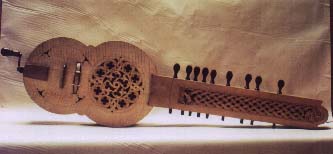

I N S T R U M E N T S
|
As you might have guessed from the album titles, harps figure prominently in the music Winter Harp. But, in addition to harps, a number of other rare instruments make up the unique sound of the ensemble. |
 |
The Medieval Instruments |
|
Winter Harp musicians play a number of unique Medieval
instruments, all hand-made specifically for the ensemble. |
|
Nyckelharpa |
|
This unique instrument, with its wistful sound, was replaced after medieval times by the violin.
However, it is still played in Sweden. |
|
|
The nyckelharpa looks like a combination of a violin and a hurdy-gurdy. Its four strings are bowed like a violin, but the notes are made with keys like a hurdy-gurdy. Its name means keyed (nyckel) stringed instrument (harpa). Underneath its four bowed strings are 12 sympathetic strings which give the instrument an especially rich resonance. The nyckelharpa first appears in one form or another around 850 AD. Here is a picture of Joachin with a much later model. |

|

In the 1970's, Canadian instrument maker Edward Turner made an organistrom for the Museum of Man in Ottawa. When Winter Harp learned of this instrument, the ensemble commissioned Edward Turner to make a second one. Mr. Turner’s organistrum is a replica based on a stone carving on the frieze over the entrance of the 12th century Cathedral of Santiago de Compostela in Spain. Elaborately carved, the organistrum takes two people to play. One person turns the wheel to produce the drone sound while the other person turns the pegs to produce the different notes. It is related to the hurdy-gurdy, also known as the Vielle a Roue.
The organistrum has a guitar shaped box with a square key box attached to it that has revolving vanes which stop the strings at pre-determined intervals to sound notes. A wooden rosined wheel "bows" the strings. Not all the strings are stopped, thus giving a bagpipe-like droning effect.
The origins of the instrument are lost in the mists of antiquity, but possibly it was brought into Europe by the Moors when they invaded Spain in the 8th century. The earliest recorded construction methods were recorded by Odo of Cluny in the 10th century.
There are various theories regarding the playing action of the organistrum, with some scholars concluding that the keys slid up and down (like in the later symphony or in the modern hurdy-gurdy). The Codex of St. Blasien copied by Martin Gerbert in the 1700's clearly shows the keys revolving, though some scholars dismiss this idea as unworkable.

Standing at a height of five feet, the imposing bass psaltery is the only one like it in the world. Made of cherry and sitka spruce, the 35-string psaltery features a Gothic rose sound hole intricately carved from wood and parchment. Psalteries date back 3,000 years to Babylonian and Sumarian times. Premier luthier Edward Turner made Winter Harp’s bass psaltery and alto psaltery.
Where did the concept of a bass psaltry come from? In February 1998, Lori Pappajohn and Joaquin Ayala had a fortuitous meeting with Edward Turner.
Lori and Joaquin had a specific instrument in mind -- one that didn’t exist -- but could if someone was adventurous enough to take on the task. They wanted a deep-voiced psaltery. Based on their concept, Edward Turner designed a five-foot tall bass psaltery. Its 35 strings produce a haunting, ethereal sound.
Concert Schedule| About the Concerts| The Performers | Medieval Instruments | School Concerts | Albums | Tour Photos | Home Page
Web page design
Last updated